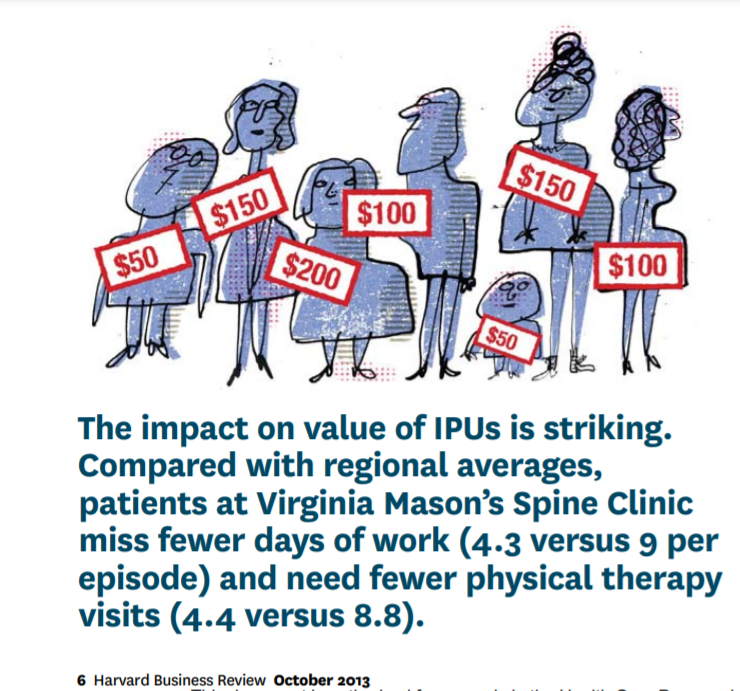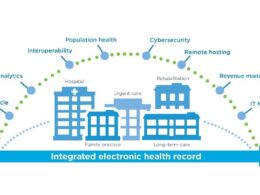Credit: vivance
Harvard Business Review
Michael Porter and Thomas Lee
October 2013
This is an excerpt of the paper: “The Strategy That Will Fix Health Care“, published in 2013, focused on the topic of “IPUs – Integrated Practice Units”.
The Value Agenda Detailed
- IPUs — Organize into Integrated Practice Units (IPUs)
- OUTCOMES & COSTS — Measure Outcomes and Costs for Every Patient
- BUNDLED PAYMENTS — Move to Bundled Payments for Care Cycles
- INTEGRATED CARE — -Integrate Care Delivery Systems
- GEOGRAPHY — Expand Geographic Reach
- IT PLATFORM — Build an Enabling Information Technology Platform
1: Organize into Integrated Practice Units (IPUs)
At the core of the value transformation is changing the way clinicians are organized to deliver care. The first principle in structuring any organization or business is to organize around the customer and the need. In health care, that requires a shift from today’s siloed organization by specialty department and discrete service to organizing around the patient’s medical condition. We call such a structure an integrated practice unit. In an IPU, a dedicated team made up of both clinical and nonclinical personnel provides the full care cycle for the patient’s condition.
IPUs treat not only a disease but also the related conditions, complications, and circumstances that commonly occur along with it-such as kidney and eye disorders for patients with diabetes, or palliative care for those with metastatic cancer. IPUs not only provide treatment but also assume responsibility for engaging patients and their families in care-for instance, by providing education and counseling, encouraging adherence to treatment and prevention protocols, and supporting needed behavioral changes such as smoking cessation or weight loss.
In an IPU, personnel work together regularly as a team toward a common goal: maximizing the patient’s overall outcomes as efficiently as possible. They are expert in the condition, know and trust one another, and coordinate easily to minimize wasted time and resources. They meet frequently, formally and informally, and review data on their own performance. Armed with those data, they work to improve care-by establishing new protocols and devising better or more efficient ways to engage patients, including group visits and virtual interactions. Ideally, IPU members are co-located, to facilitate communication, collaboration, and efficiency for patients, but they work as a team even if they’re based at different locations. (See the sidebar “What Is an Integrated Practice Unit?”)
++++++++++++++++++++++++++++++++++++++++
BOX — WHAT IS AN INTEGRATED PRACTICE UNIT?
- An IPU is organized around a medical condition or a set of closely related conditions (or around defined patient segments for primary care).
- Care is delivered by a dedicated, multidisciplinary team of clinicians who devote a significant portion of their time to the medical condition.
- Providers see themselves as part of a common organizational unit.
- The team takes responsibility for the full cycle of care for the condition, encompassing outpatient, inpatient, and rehabilitative care, and supporting services (such as nutrition, social work, and behavioral health).
- Patient education, engagement, and follow-up are integrated into care.
- The unit has a single administrative and scheduling structure.
- To a large extent, care is co-located in dedicated facilities.
- A physician team captain or a clinical care manager (or both) oversees each patient’s care process.
- The team measures outcomes, costs, and processes for each patient using a common measurement platform.
- The providers on the team meet formally and informally on a regular basis to discuss patients, processes, and results.
- Joint accountability is accepted for outcomes and costs.
++++++++++++++++++++++++++++++++++++++++
Take, for example, care for patients with low back pain-one of the most common and expensive causes of disability. In the prevailing approach, patients receive portions of their care from a variety of types of clinicians, usually in several different locations, who function more like a spontaneously assembled “pickup team” than an integrated unit. One patient might begin care with a primary care physician, while others might start with an orthopedist, a neurologist, or a rheumatologist. What happens next is unpredictable. Patients might be referred to yet another physician or to a physical therapist. They might undergo radiology testing (this could happen at any point-even before seeing a physician). Each encounter is separate from the others, and no one coordinates the care. Duplication of effort, delays, and inefficiency is almost inevitable. Since no one measures patient outcomes, how long the process takes, or how much the care costs, the value of care never improves.
Contrast that with the approach taken by the IPU at Virginia Mason Medical Center, in Seattle. Patients with low back pain call one central phone number (206–41-SPINE), and most can be seen the same day. The “spine team” pairs a physical therapist with a physician who is board-certified in physical medicine and rehabilitation, and patients usually see both on their first visit. Those with serious causes of back pain (such as a malignancy or an infection) are quickly identified and enter a process designed to address the specific diagnosis. Other patients will require surgery and will enter a process for that. For most patients, however, physical therapy is the most effective next intervention, and their treatment often begins the same day.
Virginia Mason did not address the problem of chaotic care by hiring coordinators to help patients navigate the existing system-a “solution” that does not work. Rather, it eliminated the chaos by creating a new system in which caregivers work together in an integrated way. The impact on value has been striking. Compared with regional averages, patients at Virginia Mason’s Spine Clinic miss fewer days of work (4.3 versus 9 per episode) and need fewer physical therapy visits (4.4 versus 8.8). In addition, the use of MRI scans to evaluate low back pain has decreased by 23% since the clinic’s launch, in 2005, even as outcomes have improved. Better care has actually lowered costs, a point we will return to later. Virginia Mason has also increased revenue through increased productivity, rather than depending on more fee-for-service visits to drive revenue from unneeded or duplicative tests and care. The clinic sees about 2,300 new patients per year compared with 1,404 under the old system, and it does so in the same space and with the same number of staff members.

Wherever IPUs exist, we find similar results-faster treatment, better outcomes, lower costs, and, usually, improving market share in the condition. But those results can be achieved only through a restructuring of work. Simply co-locating staff in the same building, or putting up a sign announcing a Center of Excellence or an Institute, will have little impact.
IPUs emerged initially in the care for particular medical conditions, such as breast cancer and joint replacement. Today, condition-based IPUs are proliferating rapidly across many areas of acute and chronic care, from organ transplantation to shoulder care to mental health conditions such as eating disorders.
Recently, we have applied the IPU model to primary care (see Michael E. Porter, Erika A. Pabo, and Thomas H. Lee, “Redesigning Primary Care,” Health Affairs, March 2013). By its very nature, primary care is holistic, concerned with all the health circumstances and needs of a patient. Today’s primary care practice applies a common organizational structure to the management of a very wide range of patients, from healthy adults to the frail elderly. The complexity of meeting their heterogeneous needs has made value improvement very difficult in primary care-for example, heterogeneous needs make outcomes measurement next to impossible.
In primary care, IPUs are multidisciplinary teams organized to serve groups of patients with similar primary and preventive care needs-for example, patients with complex chronic conditions such as diabetes, or disabled elderly patients. Different patient groups require different teams, different types of services, and even different locations of care. They also require services to address head-on the crucial role of lifestyle change and preventive care in outcomes and costs, and those services must be tailored to patients’ overall circumstances. Within each patient group, the appropriate clinical team, preventive services, and education can be put in place to improve value, and results become measureable.
This approach is already starting to be applied to high-risk, high-cost patients through so-called Patient-Centered Medical Homes. But the opportunity to substantially enhance value in primary care is far broader. At Geisinger Health System, in Pennsylvania, for example, the care for patients with chronic conditions such as diabetes and heart disease involves not only physicians and other clinicians but also pharmacists, who have major responsibility for following and adjusting medications. The inclusion of pharmacists on teams has resulted in fewer strokes, amputations, emergency department visits, and hospitalizations, and in better performance on other outcomes that matter to patients.
About the authors
Michael E. Porter, is the Bishop Lawrence University Professor at Harvard University. He is based at Harvard Business School.
Thomas H. Lee, is the chief medical officer at Press Ganey and the former network president of Partners HealthCare
A full version of this article appeared in the October 2013 issue of Harvard Business Review.
Originally published at https://hbr.org on October 1, 2013.












